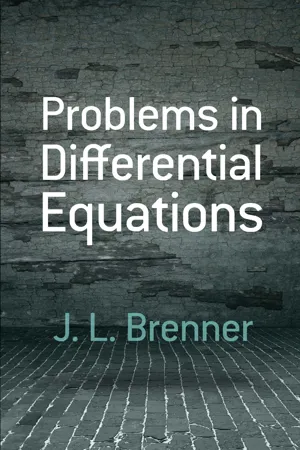
- 176 pages
- English
- ePUB (mobile friendly)
- Available on iOS & Android
Problems in Differential Equations
About This Book
A supplement for elementary and intermediate courses in differential equations, this text features more than 900 problems and answers. Suitable for undergraduate students of mathematics, engineering, and physics, this volume also represents a helpful tool for professionals wishing to brush up on their problem-solving skills.
The book is divided into twenty sections, each preceded by a clear and logical explanation of the basic ideas needed for solving the problems within the section. Many fully explained illustrative problems appear throughout the text. Subjects include applied routine and nonroutine problems in vibrations, electrical engineering, mechanics, and physics. Stars indicate advanced problems. Short mathematical and numerical tables are provided at the end of the book.
Frequently asked questions
Information


Table of contents
- Cover
- Title Page
- Copyright Page
- Preface
- Contents
- Introduction
- 1 Isoclines, Construction of the Differential Equation for a Family of Curves Isogonal Trajectories
- 2 Equations in which the Variables are Separable.
- 3 Geometrical and Physical Problems
- 4 Homogeneous Equations
- 5 Linear First Order Equations
- 6 Exact Equations
- 7 Questions on Existence and Uniqueness of Solutions
- 8 Equations in which the Derivative Appears Implicitly
- 9 Miscellaneous First Order Equations
- 10 Equations which can be Reduced to Equations of Lower Order
- 11 Linear Equations with Constant Coefficients
- 12 Linear Equations with Variable Coefficients
- 13 Series Development of Solutions of Equations
- 14 Linear Systems with Constant Coefficients
- 15 Lyapunov Stability
- 16 Singular Points
- 17 Problems in the Theory of Oscillations
- 18 Dependence of Solutions on Initial Conditions and on Parameters. Approximate Solution of Differential Equations
- 19 Non-Linear Systems
- 20 First Order Partial Differential Equations
- Answers
- Miscellaneous Formulas
- Derivatives
- Some Integrals
- Tables: Square Roots, Cube Roots